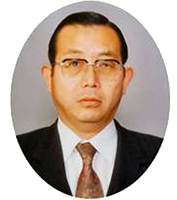第13代会長
- HOME
- 第13代会長
Message from the President
 Nowadays, a term landslide is widely used as “a downward and outward movement of slope forming materials under the influence of gravity” according to the definition of Varnes. Landslides are serious hazards for many countries located in orogenic zones. In such countries, landslides have a major socio-economic impact, as they are responsible for substantial direct and indirect social costs as well as for the loss of human lives. The protection of human lives and their living environment from landslide risks is an important aspect of public welfare policies.
Nowadays, a term landslide is widely used as “a downward and outward movement of slope forming materials under the influence of gravity” according to the definition of Varnes. Landslides are serious hazards for many countries located in orogenic zones. In such countries, landslides have a major socio-economic impact, as they are responsible for substantial direct and indirect social costs as well as for the loss of human lives. The protection of human lives and their living environment from landslide risks is an important aspect of public welfare policies.
The Japanese Archipelago is a part of the Circum Pacific Orogenic Zone and is geologically very fragile and unstable. The bedrock materials which comprise the mountainous and hilly terrain have been severely fractured since its formation and have developed numerous faults and fracture zones. The mountainous region of the Japanese territory displays a wide variety of topography with steep terrain. Furthermore, the Japanese Archipelago is located within the monsoon zone and receives abundant precipitation. Landslide areas and landslide remnants are widely distributed in most of mountainous and hilly regions in Japan. Every year, a considerable number of landslide disasters occur and result in tremendous damage.
Mitigation of landslide hazards has a significant meaning for rural and urban populations in Japan which is strongly threatened by landslide risks. It requires an appropriate scientific understanding of landslide phenomena and the risks caused by them. The Japan Landslide Society is fully committed to this task and have been promoting research activities in the filed of landslide hazard mitigation since more than forty years. The purpose of the Japan Landslide Society is to assist researchers and user groups, such as policy makers and engineers, to recognize the nature of the landslide hazards which may confront them.
The Japan Landslide Society was founded in 1963 and has been developing continuously. The Society has a current membership of about 2,000 and comprises seven branches throughout the country and its headquarter is located in Tokyo. The objectives of the Society are to:
1. exchange knowledge and experience on landslides and related phenomena and mitigation of landslide hazards;
2. promote comprehensive scientific research activities; and
3. publish results of scientific research activities.
In order to make results of research activities in public, journal publication is the most
important task of the Society. The first issue of the journal “Landslides” was appeared in 1964 and over 170 issues of the journal have been published.
Since establishment of the Japan Landslide Society, 45 annual meetings with numerous oral and poster presentations and a number of symposiums have been organized on the basis of scientific research activities performed by the member of the Society. Parallel to the journal publication, a special issue of the 6th revision of “Landslide in Japan” focusing on the current advancement of landslide research and technical development of mitigation measures was published in 2002 in order to introduce landslide phenomena in Japan to overseas researchers and engineers. It is our sincere expectation that our research activities will be distributed not only among the professional researchers and engineers, but also among the general public to increase public appreciation and technology development regarding landslide hazard mitigation.
Hideaki MARUI (Niigata University)